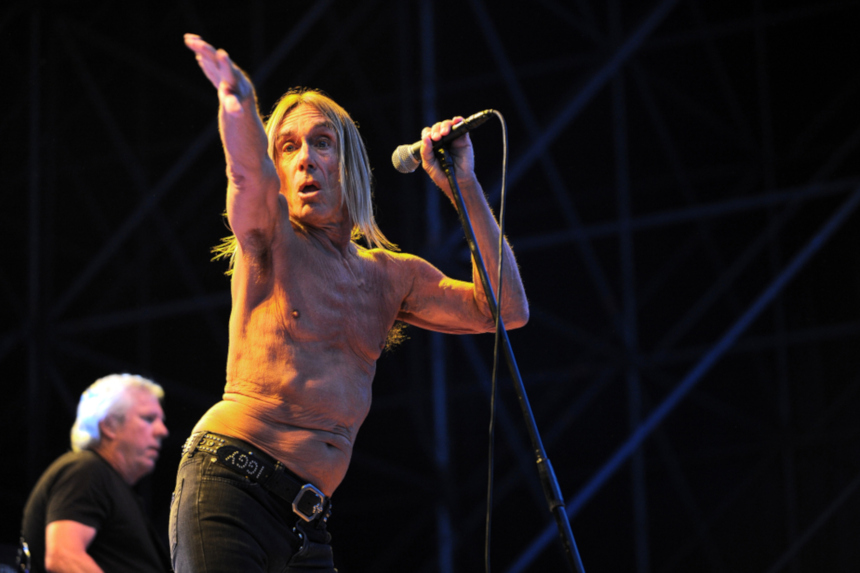No matter how you cut it, 1969 will always be one of the most significant years in music: Woodstock. Altamont. The Beatles play in public for the last time. The Who record Tommy. Johnny Cash plays San Quentin. Diana Ross and The Supremes split. It was year of wall-to-wall classic albums, from Led Zeppelin, Yellow Submarine, and Neil Young appearing in January to Let It Bleed by The Stones and the Jackson 5’s debut in December.
Tucked in among those timeless records was another release that would have a seismic impact, its influence growing as time went on. Joining The Sonics, Velvet Underground, and MC5 as a forerunner of punk, The Stooges unleashed their self-titled debut 50 years ago – yes, 50 years ago — this week, completing a foundation for punk rock that would be built upon by the New York Dolls, Patti Smith, The Ramones, Blondie, and Television.
The Stooges formed in 1967 in Ann Arbor, Michigan, near their Detroit contemporaries MC5, and they indulged in a loud and rude brand of garage rock that’s since been dubbed proto-punk. The core of the band was brothers Ron and Scott Asheton on guitar and drums, respectively, Dave Alexander on bass, and Jim Osterberg on vocals. Osterberg would be credited as Iggy Stooge on the record, but the world would soon come to know him as Iggy Pop.
The Stooges (Uploaded to YouTube by RHINO)
The Stooges soon built a reputation for intense live performances. The extremely limber and often shirtless Pop twisted his body to the music, frequently smearing himself with peanut butter and other foods, leaping off the stage, crashing into equipment, and even cutting himself. The sound of the band ran from bluesy grooves to pummeling rock, sometimes within the same song. Tunes like “I Wanna Be Your Dog” leaned heavily on three distorted guitar chords while incorporating sounds like sleigh bells and a one-note piano. When Danny Fields from Elektra Records went to scout the MC5, he saw The Stooges, too; he signed both bands.
While the intensity of the band powered their sound, it was the totally bonkers stage presence of Pop that helped cement them as iconic. Even before the first album dropped, tales of their shows were legend. Henry Rollins, former lead singer of hardcore punk legends Black Flag and The Rollins Band, grew up idolizing Pop. In a hilarious pair of videos, he recounts playing with Pop on multiple occasions throughout the ‘90s; he regards “Jim Osterberg” and “Iggy Pop” as almost two separate beings, saying, “Jim is cool; Iggy is like this terrifying monster of rock and roll.” Rollins also recalled on a VH1 special that Pop was “to my knowledge, the first guy to go off the stage into the crowd.” Alice Cooper, upon seeing Pop for the first time recalled, “I went, who is this guy? I thought I was the freakiest guy out there.”
Brian Eno said (possibly apocryphally), that not that many people bought 1967’s The Velvet Underground & Nico, but everyone that did started a band. In the case of The Stooges, they got John Cale from The Velvets to actually produce their first record. That Stooges sound was uniquely primitive and primal, and Cale managed to get that feel on the record.
As was the case with that first Velvet Underground album, The Stooges didn’t set the world on fire. Sales were modest and reviews weren’t glowing, but were frequently tinged with grudging respect. Writing for Rolling Stone at the time, Edmund O. Ward gave this classic summation: “Their music is loud, boring, tasteless, unimaginative and childish. I kind of like it.” The follow-up album, 1970’s Fun House, worked much the same way. The band earned a significant fan in David Bowie; Bowie, along with Pop, would produce the third album, 1973’s Raw Power, which featured the addition of guitarist James Williamson to the line-up.
Though the records sold poorly, they found an audience among nascent musicians, many of whom would coalesce around the New York City punk scene in the years that followed. Bands like The Ramones, Blondie, and Television were influenced by The Stooges, and Pop befriended many in that New York scene. The Stooges became a forerunner of the New York Dolls and those aforementioned acts that emerged, alongside Talking Heads and others, as the cornerstone of American punk rock. In the documentary Punk Attitude, Thurston Moore of the band Sonic Youth said that Pop never even realized that The Stooges had sold any records until he moved to New York and met bands like The Ramones that he had influenced, “which was shocking for him.”
The Stooges are inducted into The Rock and Roll Hall of Fame. (Uploaded to YouTube by Rock & Roll Hall of Fame)
Over the years, The Stooges served as an influence to musicians across a multitude of genres, notably punk and metal. Kurt Cobain of Nirvana called Raw Power his favorite album. Reunions occurred here and there with musicians moving in and out of the band, and live albums being released, but the band didn’t go back into the studio together again until 2007’s The Weirdness. By that point, The Stooges had been playing and touring together consistently again since 2003. In 2010, the band was inducted into the Rock and Roll Hall of Fame. The Stooges disbanded for good in 2016 following the deaths of the Asheton brothers and Mackay; Williamson and Pop felt that should be the end. That same year, Jim Jarmusch’s documentary about the group, Gimme Danger, was released.

The Stooges were never the biggest band, but they proved that you didn’t have to be. They played hard, lived rough, and became major influences on multiple generations of players. They got to see their music drive other bands, and then they came back to play alongside them for years. When Billie Joe Armstrong of Green Day inducted the band into the Rock Hall, he read a list of roughly 100 bands that counted The Stooges as an influence while admitting that there were legions more. Iggy sang “Raw power got a magic touch,” and he was absolutely right.
Featured image: Shutterstock.com
Become a Saturday Evening Post member and enjoy unlimited access. Subscribe now




Comments
The Sonics were nobody’s influence at the dawn of punk in the 70s. It’s revisionist history which is entirely based on their sound of delivery, not having anything to do with the salient question: “did any of the original punks listen to the Sonics“. The answer is no. Sorry about that. The Sonics aren’t even included in Lenny Kay’s Nuggets LP. Sorry about that also. Yes, The Cramps found the Sonics for themselves and were influenced by them. That’s one banded out of thousands. Let’s put this one to rest right here right now: the Velvet Underground, the MC5, the Stooges, and the New York Dolls. That’s it.